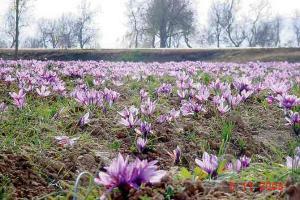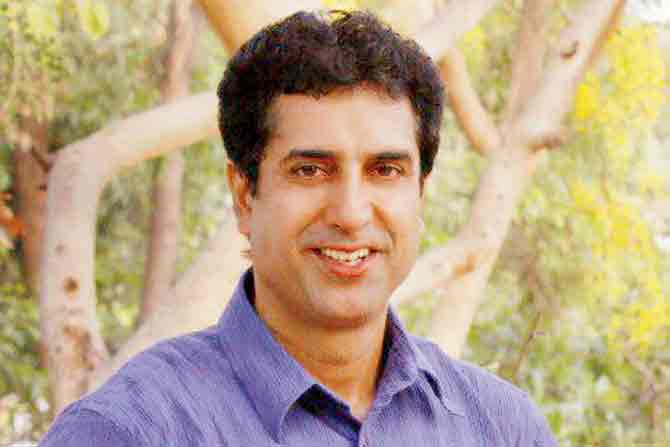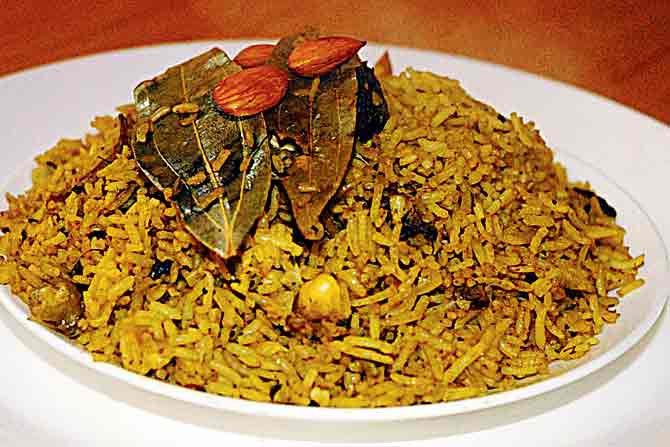Kashmiri saffrons newly acquired GI tag might be a blessing for local cultivators and suppliers as the prized spice stakes to reclaim its special status on the worlds culinary map

Saffron flowers growing on a farm. To test the authenticity of saffron, Choudhary recommends the water and aroma test. "Soak a small amount of saffron in hot water (not boiling) to see if it emits dark yellow colour and is slightly fragrant."
For entrepreneur Maroofa Khan, a favourite autumn memory is that of going to her aunts' saffron fields in Pampore, Kashmir, to play Lakad Lakad (a children's game played using a wooden stick). "I used to pluck a few flowers and keep them in my book. Years later, when I'd flip through it, the forgotten petals — dried up and tinting the pages — would serve as a reminder of the carefree afternoons spent amidst a blanket of lavender-hued flowers," recalls Khan.
In May, Kashmiri saffron got certified with a Geographical Indication (GI) from the Government of India. A GI tagging acts as a certification that the product possesses certain qualities, is made according to traditional methods, or possesses a good reputation due to its geographical origin. In Jammu and Kashmir, saffron farming is embedded in centuries of traditional practices. The crocus sativus flowers are harvested by hand for their delicate thread-like crimson-hued stigma and styles to yield what is called kesar in Hindi and zaffran in Urdu. This saffron is known for its antioxidant and cancer-fighting properties, and for its calming effects.
ADVERTISEMENT

Saffron being extracted at a processing unit
In Indian kitchens, it is used as a seasoning and colouring agent and comes with a price tag of anywhere between '1 and 3 lakh a kilo. Thankfully, only a few strands are required in dishes. The world's most expensive spice retains its high retail value because of the labour-intensive harvesting methods. Around two lakh saffron stigmas must be hand-picked from about 70,000 flowers to yield a mere pound of the spice.

Maroofa Khan
Saffron grows only in a belt from Spain to Kashmir. Iran, Greece, Morocco, Azerbaijan, Spain, Italy and India are its main producers. However, the mongra and lacha varieties of Kashmir saffron — with its long and broad headed stigmas that emit a dark yellow colour — is considered the finest and most expensive.

Rouf Ahmad Bhat
Rouf Ahmad Bhat of Organic Valley, growers and dealers of saffron in Pampore, is the great grandson of Haji Mohammad Sultan Butt, popularly known as the Saffron King of India in the early 1900s. Bhat feels in the last few years illegal Iranian saffron imports have had a major negative impact on the sale of Kashmiri saffron. "Almost 1,000 times of what comes from the legal route enters the market through the ports, thus evading taxes and being available at much cheaper prices. This is ruining our business. Last year, due to adequate moisture, we had an above-average crop after a bad spell for two years," he explains, adding, "While the new cultivation technology and irrigation infrastructure supplement yields, it is important to teach the smaller cultivators to use this infrastructure. Also, the much-hyped Saffron Park at Pampore intended to provide hi-tech machinery for processing, drying, grading, packing and marketing of saffron has been confined to paper. Now with GI tagging, smaller cultivators could benefit if they take their crop to the park for processing," feels Bhat, who is hopeful of stricter inspection to keep a check on the substandard quality saffron that passes off in the market as Kashmiri saffron.
Khan echoes the point, "GI tagging will affirm that the saffron is not adulterated and will work towards boosting the market of Kashmiri saffron including its cultivators." For many like her, saffron's fragrance is like a walk down memory lane. "We use the zaffran to lend a subtle colour to traditional dishes like rista, marchwangan korma and Kashmiri biryani," she adds.

Vanika Choudhary
For Vanika Choudhary, founder of Sequel Mumbai, her favourite saffron memory is sipping on kehwa during peak winters. "My pick is the gucchi pulao; it's basmati rice cooked with saffron, apricots, walnuts and almonds, and sweetened with jaggery. We source saffron directly from growers in Kishtawar in Jammu province, and use it to make kehwa and saffron-turmeric elixir at Sequel," she shares.

Sunil Mattoo
Hailing from Srinagar, chef Sunil Mattoo of KongPoush Kashmiri Cuisine, has named his Mumbai-based food catering service after the saffron flower. "In Kashmiri, kong poush means saffron flower. We lived near saffron fields, and loved the sight of the purple flowers in autumn. Our neighbourhood kulfi wala would make special saffron kulfi that I'd feast on regularly," he recalls. Matoo sources saffron from his cousin who runs a dry fruits shop in Jammu. "Saffron is a very expensive product, so we use it sparingly in our dishes like phirni and kahwa. This GI tagging will definitely encourage more kong kashtkars [saffron cultivators] to opt for cultivation, which has dropped recently. It will also attract more food and beverage experts across the globe to use Kashmiri saffron in their dishes," he sums up.
Kong polav (saffron pulav)

Ingredients
- 1 kg basmati rice
- 2 gms saffron
- Turmeric (a pinch)
- 150 gms chopped dry fruits
- 250 gms ghee
- 8-10 green cardamom
- 2 black cardamoms
- 2 sticks cinnamon
- 5-6 bay leaves
- Salt (according to taste)
- Raisins (to garnish)
Method
Soak long-grained basmati rice in water for two hours. Drain the water and cook rice in boiling water with added saffron and a pinch of turmeric powder. Strain the excess water when you feel that the rice is partially cooked. In another vessel, roast chopped dry fruits (almonds, cashew, chopped dry coconut and pistachios) in ghee for around five minutes. Add green cardamom, black cardamom, cinnamon, bay leaves and salt to it. Mix partially cooked saffron rice and dry fruits together, and cook the mixture on slow fire in a thick bottomed vessel for 10 minutes with a sealed lid. After putting the flame off, wait for 10 minutes before removing the lid. Serve warm and garnish with strands of saffron and raisins.
Keep scrolling to read more news
Catch up on all the latest Mumbai news, crime news, current affairs, and a complete guide from food to things to do and events across Mumbai. Also download the new mid-day Android and iOS apps to get latest updates.
Mid-Day is now on Telegram. Click here to join our channel (@middayinfomedialtd) and stay updated with the latest news
 Subscribe today by clicking the link and stay updated with the latest news!" Click here!
Subscribe today by clicking the link and stay updated with the latest news!" Click here!







